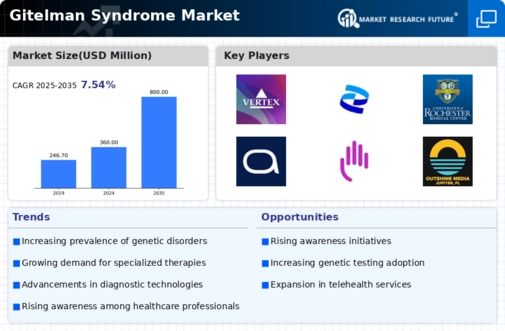Advancements in Genetic Testing
Technological advancements in genetic testing are significantly influencing the Global Gitelman Syndrome Market Industry. Enhanced diagnostic tools allow for more accurate identification of the genetic mutations associated with Gitelman Syndrome. As genetic testing becomes more accessible and affordable, healthcare providers are likely to adopt these technologies, facilitating timely diagnosis and personalized treatment plans. This trend may lead to an increase in patient numbers and, consequently, a market growth trajectory that could reach 800 USD Million by 2035. The integration of genetic testing into standard care practices is expected to enhance patient outcomes and drive market expansion.
Development of Targeted Therapies
The development of targeted therapies for Gitelman Syndrome is emerging as a significant driver within the Global Gitelman Syndrome Market Industry. Pharmaceutical companies are investing in research and development to create innovative treatment options that specifically address the underlying causes of the syndrome. These targeted therapies may offer improved efficacy and safety profiles compared to traditional treatments. As these therapies enter the market, they are expected to attract attention from healthcare providers and patients alike, potentially leading to increased market value. The anticipated growth trajectory suggests that the market could reach 800 USD Million by 2035.
Enhanced Patient Support Programs
Enhanced patient support programs are playing a vital role in shaping the Global Gitelman Syndrome Market Industry. These programs aim to provide comprehensive care, education, and resources for individuals diagnosed with Gitelman Syndrome. By offering support in managing symptoms and navigating treatment options, these initiatives may improve patient adherence to prescribed therapies. The focus on patient-centered care is likely to foster a more engaged patient population, which could contribute to market growth. As the industry evolves, the integration of such programs may become a standard practice, further driving demand for Gitelman Syndrome-related healthcare services.
Increasing Awareness of Gitelman Syndrome
The growing awareness surrounding Gitelman Syndrome is a pivotal driver for the Global Gitelman Syndrome Market Industry. As healthcare professionals and patients become more informed about the condition, the demand for diagnostic and therapeutic options is likely to rise. Educational initiatives and advocacy groups are actively promoting understanding of the syndrome, which may lead to earlier diagnosis and treatment. This heightened awareness is expected to contribute to the market's growth, with projections indicating a market value of 360 USD Million in 2024, reflecting the increasing need for specialized care and management of Gitelman Syndrome.
Rising Prevalence of Electrolyte Disorders
The rising prevalence of electrolyte disorders, including Gitelman Syndrome, is a crucial factor propelling the Global Gitelman Syndrome Market Industry. As lifestyle changes and dietary habits contribute to an increase in these disorders, more individuals are being diagnosed with Gitelman Syndrome. This trend is likely to result in a greater demand for treatment options and healthcare services tailored to managing electrolyte imbalances. The market is projected to experience a compound annual growth rate of 7.53% from 2025 to 2035, indicating a robust growth potential driven by the increasing incidence of related health issues.






















